
Sunday October 30, 2022
By Tom Joyner
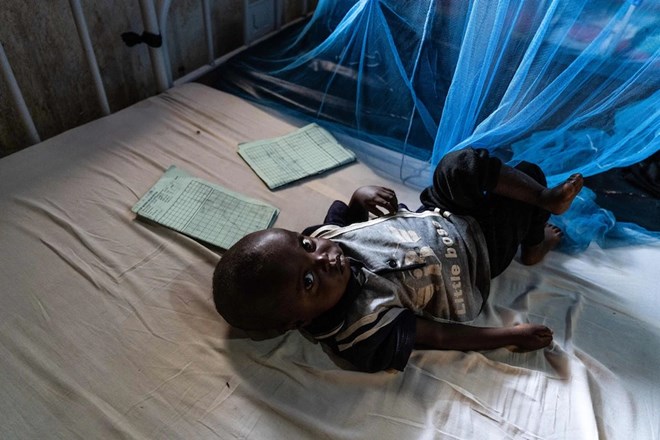
The UN predicts a famine will be declared in parts of Somalia within weeks, though aid workers warn the situation is already dire.(ABC News: Tom Joyner)
Kadjiay Moalim Mayow trudged through the dawn with her four children in tow, her knotted stomach driving her feet mechanically underneath.
Ahead and behind her was a convoy of others from her village near Dinsoor in the southern Somali desert. Everyone was silent and exhausted.
The only sounds were their rhythmic footsteps in the gravel, and the occasional braying of a donkey.
Kadjiay could tell the strength of her two youngest children, Shukri and Abdirashiid, was waning — their skin was sallow and their faces sunken.
No-one had eaten properly in days.
On the morning of the third day of their journey, Shukri didn't stir. The girl was dead. Nearby villagers told Kadjiay to bury her so the body didn't rot under the sun and attract animals.
Shukri's brother, four-year-old Abdirashiied, followed three days later. There was no time even for a funeral — Kadjiay swept up her two remaining children and turned to face the road.
"Why should we stand and wait?" she said. "We were still so hungry."
Across Somalia, the worst drought in half a century is searing the landscape, wiping out livestock and decimating crops.
Families in rural areas that were once able to grow sorghum, a common grain, or raise goats to feed themselves with enough left over to sell at the market, have been left to starve.
Made worse by a changing climate, the failure of the past four rainy seasons has left land parched and crops wilted and lifeless. Little has grown in years.
Aid workers in the area anticipate an apocalyptic scene if help doesn't arrive soon: mass death and displacement, particularly among children.
On the precipice of famine, Somalia is already in dire straits
"I've never seen anything like it," says Paul Healy from the Irish charity Trocaire, which runs several healthcare clinics in the southern Gedo region.
Within weeks, the UN predicts a famine will be declared in parts of the country — a technical determination that critics say is abstract from day-to-day reality.
"People seem to be waiting for a famine, and waiting for a famine will be too late," Mr Healy says.
There is barely a village across the country untouched by the drought.
The most vulnerable are already stricken by catastrophic hunger and fearful of violent insurgency by militants from Al Shabaab — the Islamist group that controls swathes of Somali territory and is responsible for attacks that have killed civilians, including in the capital Mogadishu.
On the edge of towns in the Gedo region, informal camps full of people who have fled their homes in search of food stretch for kilometres.
Residents fashion colourful makeshift shacks from sticks and scavenged fabric in the dirt.

Families once able to feed themselves and make a living have been left to starve.(ABC News: Tom Joyner)
Thorny brambles arranged in rings around their base double as shields against the wind and fences to protect from unwanted visitors.
When it does rain, the roads turn to mud.
The more enterprising, or those with something to contribute, do what they can to help others, forming a kind of unofficial support net for the newest arrivals.
When there is a wedding between two in a camp, residents pool their resources to construct a shelter for the newlyweds. The camp lights up with song and laughter, there are howls and dancing into the night.
Thousands who turn up every week with little more than the clothes they are wearing are offered water and hot food by their neighbours. If a child is sick, they are given directions to a clinic in a nearby town.
Aden Moallim Mohamed, a self-described leader of one camp, who himself arrived earlier in the year, shows exhausted mothers how to plant scavenged deadwood into the soil to build the base of a shelter.
"We learned this building technique by pure circumstance," he says with a grin while walking through the camp.
Inside displacement camps, 'we share what we have'
In Dolow, a small community in Gedo along the Somali-Ethiopian border, roughly 150,000 people crowd the camps around the edge, far eclipsing the residents of the town itself.
Life in the camps is bleak and precarious. Every resident knows to expect a difficult night when storm clouds gather overhead.
A few hours' deluge is not enough on its own to break the drought, but is sure to cause havoc among the dwellings, which quickly turn into muddy disarray.
Mr Mohamed recently spent a wet night underneath a rubber mat in a neighbour's shelter, the pair trying to keep each other dry.
"We share what we have," he says.
Sanitation is almost non-existent without proper toilets in most camps.
Disease is common. If uncontained, an outbreak of measles, for example, can spread quickly and kill children already weakened by malnutrition.
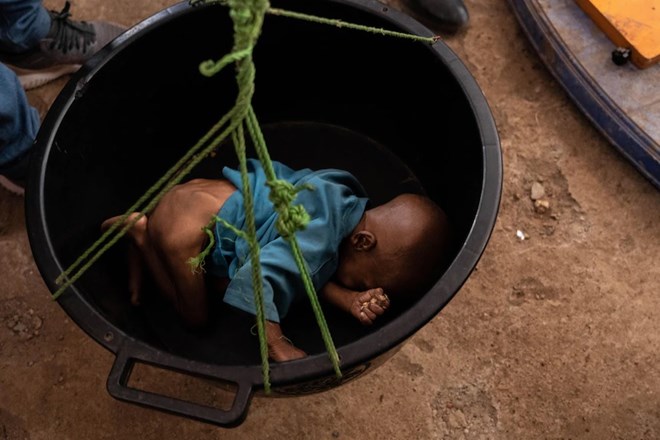
Though famine has not yet been declared in Somalia, aid workers are preparing for mass deaths of malnourished children.(ABC News: Tom Joyner)
At Mr Mohamed's camp, on the edge of Baidoa, a major centre in the Gedo region, many residents have lived there for months, and in some cases years.
For many, there is nothing to return home to and nothing to look forward to. Life as they know it will eventually come to an end in the muddy squalor of the camp.
All that remains is a daily struggle to stay alive.
"I have come here with no intent of leaving," says Muslimay Durow, a mother of 10 who arrived after a journey of 90 kilometres by foot.
"We are waiting here for the mercy of God."
As she speaks, her youngest child cries of thirst. She disappears and returns moments later with a small cup of water, which the child gulps gratefully.
Even in towns like Dolow, which attracts thousands of displaced people because of the heavy presence of aid organisations, public health care is severely limited.
The town itself is a modest grid of dusty streets, where young men sit idly outside shopfronts and wild goats chew on weeds that crowd hillsides.
Somali schoolgirls walk home in groups, wearing colourful garbasaar (a religious shawl) as Ethiopian soldiers slouch in the shade of military checkpoints.
On the outskirts, the town's airstrip receives daily UN humanitarian flights.
The burnt-out wreckage of a jet aircraft registered to Tajikistan lies abandoned along the edge of the apron.
Above the terminal entrance, a sheet of white plastic covers the first part of the sign that hangs above that once read 'international airport'. It now reads 'national airport'.
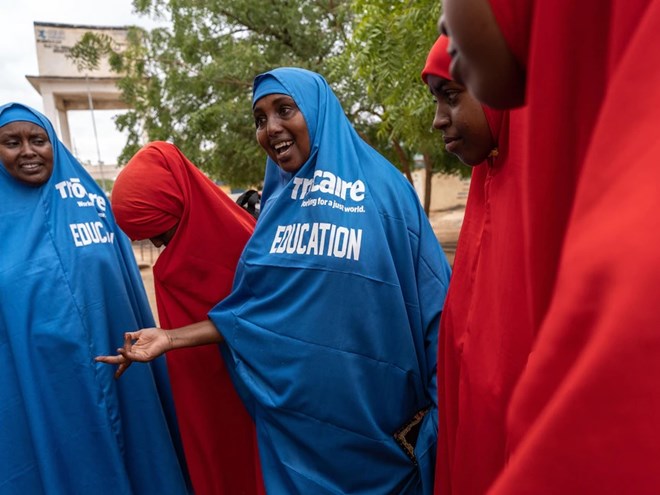
Sadia Adan Ibrahim, centre, is among the women who encourage families at the camps to send their daughters to school.(ABC News: Tom Joyner)
At malnourishment clinics, babies cling on for life
A short drive away is the town's only stabilisation centre, a specialised clinic set up to treat the severely malnourished.
Every morning, Somali women arrive clutching stricken babies, many of them close to death and showing symptoms of diarrhoea, infection or fever.
"The situation is very serious at the moment," says Pamela Wesonga, the centre's head of nutrition.
Staff use a band slipped over each child's upper arm to measure its circumference. A reading of 11.5 centimetres or less indicates acute malnutrition.
Throughout the centre's only room, women lay exhausted in beds as their starving children sleep or cry. Ms Wesonga estimates nine in 10 live in the camps on the town's outskirts.
Some of the children have swollen limbs and torsos — symptoms of oedema, a condition developed in the most severe cases of malnutrition.
Three times a day, nurses under Ms Wesonga's watch prepare a formula of therapeutic milk to give to the babies — the only thing their weak stomachs can handle.
Later, when they're ready, they're given Plumpy'nut, a nutrition-dense supplement that tastes like peanut butter.
A whiteboard in the stabilisation centre's office showing the year's patient data tells the story of the drought's effect on children: admissions have more than tripled from 42 in January to 154 in July.
"The number of children you see here is just a fraction of the total number who are malnourished in the community," says Shueb Abdishakur Ali, a Somali physician who performs regular check-ups on the patients.
"A number of them might actually die within the camps."
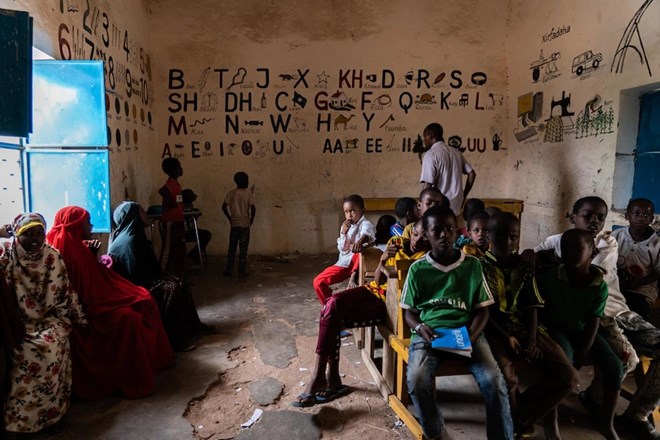
Abdirizak Olad Bale says children from the displacement camps, many of whom have nothing to eat, tend to struggle to keep up.(ABC News: Tom Joyner)
Girls are missing out on education to help families get by
The drought has also kept children out of school.
In particular, girls from displaced families living in camps are expected to help with domestic duties rather than attend class — a privilege reserved exclusively for boys.
In one camp near Dolow, outreach workers — often women who live in the camp themselves — go shelter to shelter to try to convince parents to send their daughters to the primary school in town.
There are 40 such women in total, working daily across two camps.
They keep a keen eye out for girls who miss attendance, following up with them back in the camps.
They check what girls have learned to make sure there are no gaps in their learning year to year.
"Some of the mothers fight us," says Sadia Adan Ibrahim, one of the outreach workers.
"They say to me 'you always talk about school but you never give us any food'."
For those children from the camps who do turn up to school, there is a powerful incentive: three hot meals provided free of charge every day.
One October morning, about 30 children who had come from local camps followed a teacher, Abdirizak Olad Bale, as he taught a lesson in the Somali alphabet.
Boys and girls of different ages took turns marching to the front of the room to recite the letters, making sure not to miss any.
The children from the camps are sometimes years behind in their schooling, says Mr Bale, and struggle to grasp concepts that those from town might pick up more easily.
"There are some that are coming without shoes even," he says.
When the lesson ends about midday, the children file out of the classroom and sit in the shade of a tree in the yard, where Somali women have brought them plates of rice, banana and goat meat.
They sit in groups of three, eating with their hands in silence.
"But they want to learn."
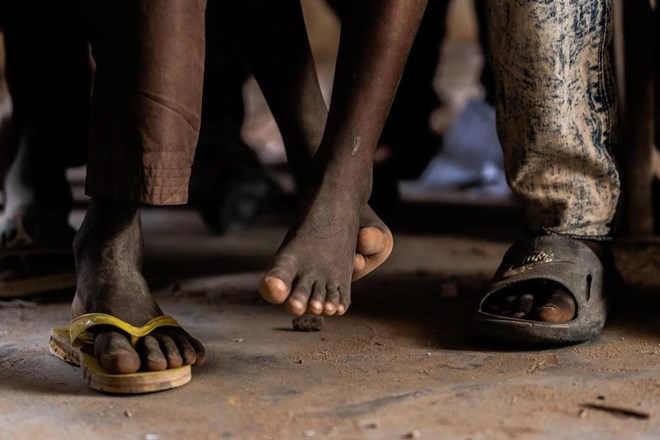
The drought has kept many children away from school, but those who do come say they want to learn.(ABC News: Tom Joyner)